Hidden wiring indicator: operating principle and instructions for use
When drilling holes in an unfamiliar wall, it is easy to get an electrical injury or damage the wiring through a short circuit by getting into a live cable. To prevent such situations, a hidden wiring indicator (HWI) is used.For a device to be useful, you need to know how to use it. Do you agree?
We will introduce you to all types of devices currently used to determine the route of hidden electrical wires. Let's talk about the operating principles and rules for selecting indicators. For independent home craftsmen, the article we presented provides operating instructions.
The content of the article:
Types of electrical wiring indicators
Not all hidden wiring indicators have the same operating pattern and functions. Manufacturers are trying to provide equipment with additional options to gain competitive advantages. Because of this, there are several classification categories of detectors that need to be understood in detail.
According to the physical principles of operation
The main division of hidden wiring indicators occurs according to the physical principles on which their work is based.
There are the following types of detectors:
- electromagnetic;
- metal detectors;
- electrostatic;
- combined devices.
Electrostatic detectors are able to detect live wires without passing current through them. They have a low price and are easy to use.
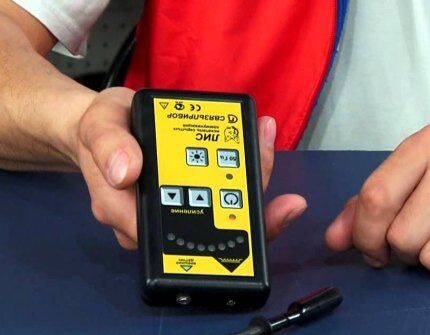
With the help of electrostatic detectors, it is easy to detect cable breaks. The disadvantages of these devices include high sensitivity to induced electromagnetic interference. The normal operation of detectors can be disrupted by routers, microwave ovens, computers, and televisions connected to the network.
Electrostatic indicators are also not suitable for locating wiring in damp walls and metal-reinforced structures.
Electromagnetic ICPs can only detect wires carrying current. For budget models, the minimum load on the network for the device to operate correctly is 1 kW.
That is, using such a detector it will be almost impossible to determine the wiring going to lamps and chandeliers. The advantage of such devices is their high accuracy, which allows you to track the location of an electrical cable down to a few millimeters.
Metal detectors in their pure form are rarely used as wiring indicators because they react equally to copper pipes or wire, and on metal fittings, and on nails and wire clamps.
In ICP, metal detectors are typically used to confirm weak or intermittent signals received by other sensors.

Combined hidden wiring indicators are expensive, but also have good functionality. By using multiple detection methods simultaneously, these devices provide high operating efficiency. In addition, combined ISPs are often equipped with additional functions that professional electricians need.
Inexpensive electrostatic indicators are quite suitable for household use; they are enough to determine the surface apartment wiring.
According to performance characteristics
Hidden wiring indicators have a lot of structural and functional differences, so they can be divided into several categories.
According to the scope of application, ISP are divided into:
- household;
- professional.
Household detectors usually do not contain metal sensors, so their use on reinforced walls is highly effective. The cost of the simplest devices starts from $5.They are equipped with one sensor, as well as a light or sound indicator for detecting electrical wiring.
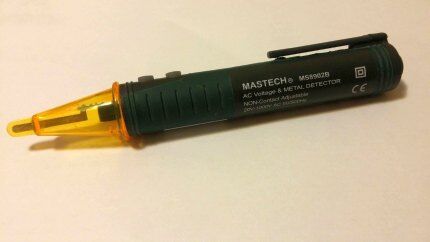
Some professional models can even detect cables at a depth of up to 150 mm with an accuracy of 5 mm. Their cost can reach $500-600, with the same dimensions as household detectors.
Wiring detection indications can be of the following types:
- sound;
- light;
- graphic;
- combined.
Light and sound indication is realized using an LED or an audio speaker, respectively. Sometimes signal intensity correlates with the power of electromagnetic radiation. Graphic indication is displayed on the liquid crystal display.
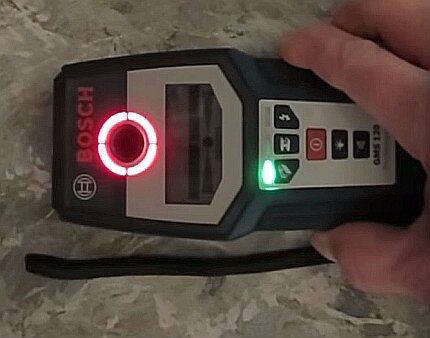
By appearance, ISP can be divided into:
- cylindrical;
- flat.
Cylindrical devices are usually an indicator screwdriver with the function of detecting hidden wiring. Such models are low-functional, but also cheap. Screwdrivers are capable of detecting electrical cables usually at a depth of no more than 2 cm.
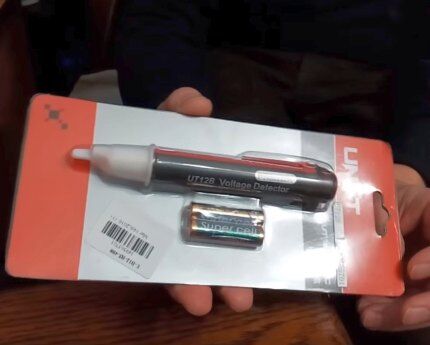
The cost of the detector depends largely on the depth of detection of hidden wiring and additional functionality. Therefore, you should study the operating principle and scope of various indicator models.
Operating principle of the detector
The operating principle of the hidden wiring indicator is quite simple.
It usually consists of three elements:
- electromagnetic field sensor;
- amplifier;
- indicator.
The simplest ISP diagram is shown in the figure. You can assemble it yourself using basic parts purchased on the radio market.

The operation of electrostatic devices (for example, the “Woodpecker” model) is ensured by the property of the transistor to change resistance when there is interference at the gate output. Metal detector sensors are based on recording currents arising in a metal object under the influence of the magnetic field of the inductor coil of the ICP itself.
Devices with sensitivity control and additional functions have more complex circuits, but the basic elements remain relevant.
Areas of application of indicators
The scope of application of the IPS depends on the configuration of the device and its sensitivity.
Basic models of combined detectors can be used for the following purposes:
- identification of hidden electrical wiring in ceilings, walls, floors;
- detection of electrical cable breaks;
- correct connection of electric meter phases;
- determination of phase wire;
- detection of ungrounded equipment;
- checking the serviceability of fuses and fuses;
- detection of locations of metal reinforcement in the wall,
Additional features of the ISP include the following functions:
- indication of objects of the types “non-metal”, “non-magnetic metal”, “magnetic metal”, “live wiring”;
- determination of surface temperature;
- indication of detection accuracy as a percentage;
- tree detection;
- automatic detection of the center of metal objects.
You need to think about the required functionality before purchasing a detector, because the price of devices with minimum and maximum components can differ by 50-100 times.
Rules for choosing a hidden wiring indicator
Models of hidden wiring indicators, for the most part, guarantee the functionality described in the instructions.

However, there are features of choice that the average person does not think about when purchasing specialized electrical equipment.
They are listed in the form of a list of rules:
- The physical parameters of foreign power grids may differ greatly from domestic ones, so you should not buy power supply systems that are not certified under national legislation.
- It is necessary to take into account the material of the walls in the place where the device is intended to be used and the depth of the wiring.
- When determining the locations of inactive wiring, devices with metal sensors are needed.
- After purchasing the device, it is advisable to check its performance in the store. The detection depth can be assessed by covering the cable with a ceramic tile, wooden board or sheet of foam.
- Due to their simplicity of design, budget models can be more durable than ICPs with complex electronic circuits.
When purchasing a hidden wiring detector, you should definitely consult with the seller, because if you choose on your own, there is a high probability that the purchased equipment will not fully meet the tasks assigned to it.
The following photo selection will introduce you to the detector models that are in demand on the market, allowing you to accurately determine the position of the hidden wiring route:
Instructions for using the detector
Due to the variety of designs of hidden wiring indicators, it is necessary to consider the instructions for their use using the example of a specific model. For this purpose, the inexpensive electrostatic ISP “Dyatel E-121”, widely used by domestic installers, was chosen. But first you need to prepare for the search procedure.
Preparing for upcoming work
To speed up the detection of electrical wiring using any detector, experienced specialists suggest following a number of simple rules.
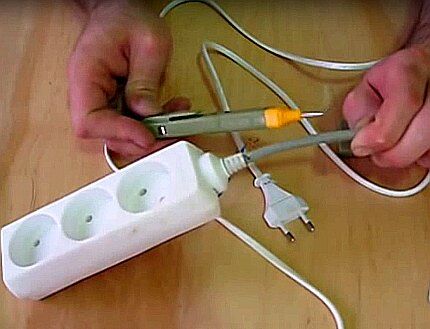
Below are the main ones:
- Initially, test the functionality of the device on any live wire. The batteries in the detector may simply run out and it will not work correctly.
- Calibrate the device at a distance of 1 meter from the walls, if such an option is present.
- The surfaces to be tested should not be wet.
- If possible, turn off all working electrical appliances in the apartment, including telephones.
- The accuracy of electrical wiring detection will be greatly reduced if conductive wallpaper adhesive was used.
These recommendations will eliminate wastage of time due to inoperative equipment and unacceptable parameters of the surface under study.
Using the Woodpecker E-121 detector
The Woodpecker E-121 detector is capable of operating in 4 sensitivity ranges.
The procedure for using this device to detect wiring is as follows:
- Press the sensitivity range buttons one by one. In this case, the signaling device should emit a short light and sound signal. If the device does not respond, check the battery.
- Press button “4” (provides maximum sensitivity), bring the detector to the surface being analyzed and, if there is an indication, reduce sensitivity by pressing buttons “3” to “1” in sequence.
- Simultaneously with the decrease in sensitivity, it is necessary to reduce the distance to the detected object, localizing the alarm zone.
- To detect the location of the conductor, move the detector along the wall, trying to find the area with the maximum electromagnetic field.
- To neutralize interfering surrounding currents, place your hand on the surface to be analyzed near the detector. If there is no conductor near the hand, then “Woodpecker E-121” will stop giving signals.
- When searching for a broken wire, apply voltage to the damaged core and ground the rest.
The accuracy of determining the location of an electrical cable depends on the degree of humidity and the materials surrounding the wire.
Locating electrical wires in plaster walls, reinforced concrete panels and ground shields will be difficult.
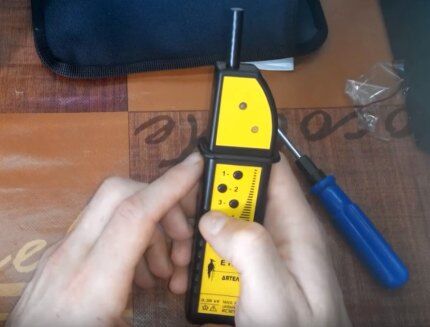
To test fuses and fuse links, you must turn on mode “1” or “2” and touch the antenna to the contacts before and after the fuse. If there is a malfunction, the detector will not generate a signal.

To correctly interpret the results of the device’s operation, you should first read its instructions, because almost every detector requires correct initial settings.
Conclusions and useful video on the topic
Video materials will help you see the action of various detectors in operation and evaluate the real benefits of expensive models. A comparison of the performance of hidden wiring indicator models of different price ranges is presented.
Video #1. Working with ISP “Woodpecker E-121”:

Video #2. Comparison of four hidden wiring detectors:

Video #3. Review of expensive and cheap hidden wiring indicator:

The effectiveness of a device for detecting hidden wiring does not always correlate with its price.The most important factor that must be taken into account when choosing a device is the characteristics of the immediate object of examination. And if it is uncertain, you need to discuss in the store the possibility of exchanging the detector for another model.
Tell us about how you used the indicator to determine the route of hidden wiring or to detect its breakage. Please write comments in the block below, ask questions and post photos on the topic of the article. Share useful information and technological subtleties that you know.




Modern technologies are developing very rapidly, so if you don’t have a hidden wiring detector at hand, don’t despair. If your smartphone has a magnetic sensor function, then simply download the Metal Detector application. Yes, you won’t get 100% accuracy, but you can determine the location of the wiring. In addition, there are now many devices on the Internet that can be assembled from improvised materials. I still recommend using proven chipboards, but if there is an urgent need and the device is not at hand, it is better to use the above methods.
So, does a smartphone with Metal Detector detect wiring normally? Sounds, to be honest, doubtful.
When I was covering the hallway walls with MDF panels, I bought myself the simplest detection detector in the form of a small screwdriver. Even he was able to determine the exact position of the cables behind the wall. So yes, it's a useful thing.